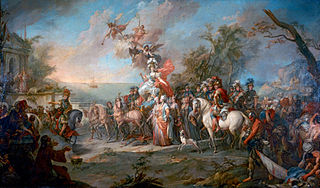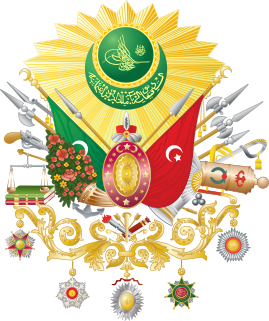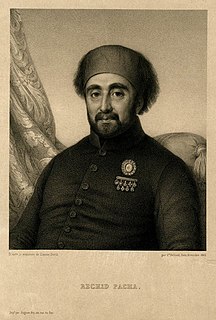
Abdulaziz was the 32nd Sultan of the Ottoman Empire and reigned between 25 June 1861 and 30 May 1876. He was the son of Sultan Mahmud II and succeeded his brother Abdulmejid I in 1861.

The Balkan Wars consisted of two conflicts that took place in the Balkan Peninsula in 1912 and 1913. Four Balkan states defeated the Ottoman Empire in the First Balkan War. In the Second Balkan War, Bulgaria fought against all four original combatants of the first war. It also faced an attack from Romania from the north. The Ottoman Empire lost the bulk of its territory in Europe. Although not involved as a combatant, Austria-Hungary became relatively weaker as a much enlarged Serbia pushed for union of the South Slavic peoples. The war set the stage for the Balkan crisis of 1914 and thus served as a "prelude to the First World War".

The Ottoman Empire was a state that controlled much of Southeastern Europe, Western Asia, and Northern Africa between the 14th and early 20th centuries. It was founded at the end of the 13th century in northwestern Anatolia in the town of Söğüt by the Turkoman tribal leader Osman I. After 1354, the Ottomans crossed into Europe and with the conquest of the Balkans, the Ottoman beylik was transformed into a transcontinental empire. The Ottomans ended the Byzantine Empire with the conquest of Constantinople in 1453 by Mehmed the Conqueror.

The Crimean War was a military conflict fought from October 1853 to February 1856 in which Russia lost to an alliance made up of France, the Ottoman Empire, the United Kingdom and Sardinia. The immediate cause of the war involved the rights of Christian minorities in the Holy Land, then a part of the Ottoman Empire. The French promoted the rights of Roman Catholics, while Russia promoted those of the Eastern Orthodox Church. Longer-term causes involved the decline of the Ottoman Empire and the unwillingness of Britain and France to allow Russia to gain territory and power at the Ottoman Empire's expense. It has widely been noted that the causes, in one case involving an argument over a key, have never revealed a "greater confusion of purpose", yet they led to a war that stood out for its "notoriously incompetent international butchery".

The Treaty of Paris of 1856 brought an end to the Crimean War between the Russian Empire and an alliance of the Ottoman Empire, Great Britain, the Second French Empire and the Kingdom of Sardinia.

The Russo-Turkish War of 1768–1774 was a major armed conflict that saw Russian arms largely victorious against the Ottoman Empire. Russia's victory brought Kabardia, part of Moldavia, the Yedisan between the rivers Bug and Dnieper, and Crimea into the Russian sphere of influence. Though a series of victories accrued by the Russian Empire led to substantial territorial conquests, including direct conquest over much of the Pontic–Caspian steppe, less Ottoman territory was directly annexed than might otherwise be expected due to a complex struggle within the European diplomatic system to maintain a balance of power that was acceptable to other European states and avoided direct Russian hegemony over Eastern Europe.

The Ottoman Empire was founded circa 1299 by Osman I as a small beylik in northwestern Asia Minor just south of the Byzantine capital Constantinople. The Ottomans first crossed into Europe in 1352, establishing a permanent settlement at Çimpe Castle on the Dardanelles in 1354 and moving their capital to Edirne (Adrianople) in 1369. At the same time, the numerous small Turkic states in Asia Minor were assimilated into the budding Ottoman sultanate through conquest or declarations of allegiance.
In diplomatic history, the Eastern Question was the issue of the political and economic instability in the Ottoman Empire from the late 18th to early 20th centuries and the subsequent strategic competition and political considerations of the European great powers in light of this. Characterized as the "sick man of Europe", the relative weakening of the empire's military strength in the second half of the eighteenth century threatened to undermine the fragile balance of power system largely shaped by the Concert of Europe. The Eastern Question encompassed myriad interrelated elements: Ottoman military defeats, Ottoman institutional insolvency, the ongoing Ottoman political and economic modernization programme, the rise of ethno-religious nationalism in its provinces, and Great Power rivalries.

In the late eighteenth century, the Ottoman Empire faced numerous enemies. In response to these threats, the empire initiated a period of internal reform which came to be known as the Tanzimat, which succeeded in significantly strengthening the Ottoman central state, despite the empire's precarious international position. Over the course of the nineteenth century, the Ottoman state became increasingly powerful and rationalized, exercising a greater degree of influence over its population than in any previous era. The process of reform and modernization in the empire began with the declaration of the Nizam-I Cedid during the reign of Sultan Selim III and was punctuated by several reform decrees, such as the Hatt-ı Şerif of Gülhane in 1839 and the Hatt-ı Hümayun in 1856. By 1908, the Ottoman military became modernized and professionalized along the lines of Western European armies. The period was followed by the defeat and dissolution of the Ottoman Empire (1908–1922).

Koca Mustafa Reşid Pasha was an Ottoman statesman and diplomat, known best as the chief architect behind the Ottoman government reforms known as Tanzimat.

Omar Pasha, also known as Omer Pasha Latas was an Ottoman field marshal and governor. Born in Austrian territory to Serbian Orthodox Christian parents, he initially served as an Austrian soldier. When faced with charges of embezzlement, he fled to Ottoman Bosnia in 1823 and converted to Islam; he then joined the Ottoman army, where he quickly rose through the ranks. Latas crushed several rebellions throughout the Ottoman Empire, and served as a commander in the Crimean War of 1853-1856, where he won some outstanding victories at Silistra (1854) and Eupatoria (1855) and participated in the Siege of Sevastopol (1854–1855).

The dissolution of the Ottoman Empire (1908–1922) began with the Second Constitutional Era. The 1908 Young Turk Revolution restored the constitution of 1876, which brought in multi-party politics with a two-stage electoral system for the Ottoman parliament. Within the empire, the new constitution was initially seen positively, as an opportunity to modernize state institutions and resolve inter-communal tensions between different ethnic groups.
The Russo-Turkish wars were a series of twelve wars fought between the Russian Empire and the Ottoman Empire between the 16th and 20th centuries. It was one of the longest series of military conflicts in European history. Except for the war of 1710–11 and the Crimean War, which is often treated as a separate event, the conflicts ended disastrously for the stagnating Ottoman Empire; conversely they showcased the ascendancy of Russia as a European power after the modernisation efforts of Peter the Great in the early 18th century.

The economic history of the Ottoman Empire covers the period 1299–1923. Trade, agriculture, transportation, and religion make up the Ottoman Empire's economy.
The German–Ottoman alliance was ratified by the German Empire and the Ottoman Empire on August 2, 1914, shortly following the outbreak of World War I. It was created as part of a joint effort to strengthen and modernize the weak Ottoman military and to provide Germany with safe passage into the neighbouring British colonies.
The foreign relations of the Ottoman Empire were characterized by competition with the Persian Empire to the east, Russia to the north, and Austria to the west. The control over European minorities began to collapse after 1800, with Greece was the first to break free, followed by Serbia. Egypt was lost in 1798–1805. In the early 20th century Austria-Hungary annexed Bosnia and Herzegovina, the Bulgarian Declaration of Independence soon followed. The Ottomans lost nearly all their European territory in the First Balkan War (1912–1913). The Ottoman Empire allied itself with Germany in the First World War, and lost. The British successfully mobilized Arab nationalism. The Ottoman Empire thereby lost its Arab possessions, and itself soon collapsed in the early 1920s. For the period after 1923 see Foreign relations of Turkey.

Abdulmejid I, was the 31st Sultan of the Ottoman Empire and succeeded his father Mahmud II on 2 July 1839. His reign was notable for the rise of nationalist movements within the empire's territories. Abdulmejid wanted to encourage Ottomanism among secessionist subject nations and stop rising nationalist movements within the empire, but despite new laws and reforms to integrate non-Muslims and non-Turks more thoroughly into Ottoman society, his efforts failed.

The Great Eastern Crisis of 1875–78 began in the Ottoman Empire's territories on the Balkan peninsula in 1875, with the outbreak of several uprisings and wars that resulted in the intervention of international powers, and was ended with the Treaty of Berlin in July 1878.

Varna was a Sultan Makhmud-class ship of the line built for the Imperial Russian Navy's Black Sea Fleet in the late 1830s and early 1840s. The ship had an uneventful career, apart from routine peacetime operations in the 1840s, interrupted by periods in reserve. In October 1853, she helped carry soldiers to the Caucasus to strengthen the Russian position there at the start of the Crimean War. In need of repairs, she was unable to take part in the Battle of Sinop in November, and thereafter remained in Sevastopol during the siege of the city. Her crew was sent ashore to reinforce the defenses and Varna was scuttled as a blockship in 1854 to bar the harbor entrance to French and British warships.
















